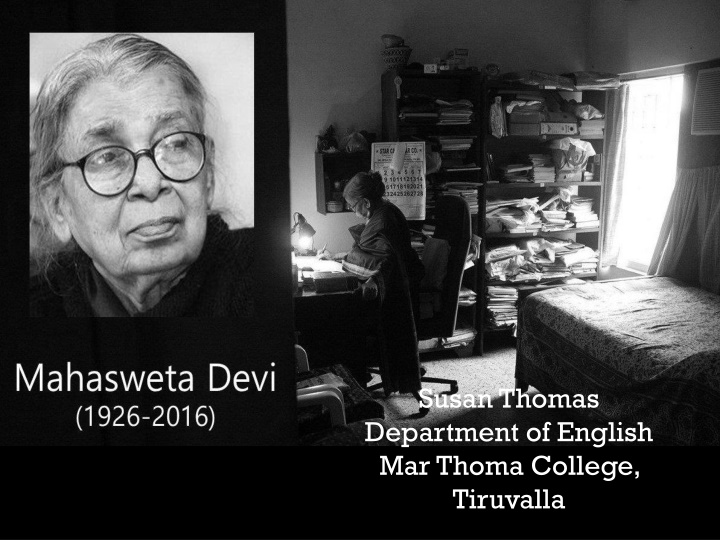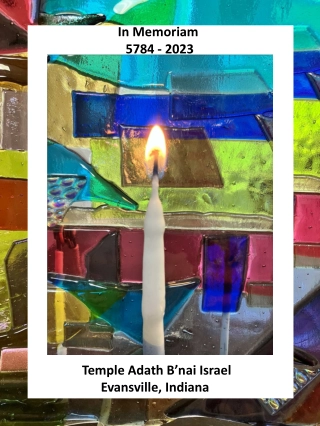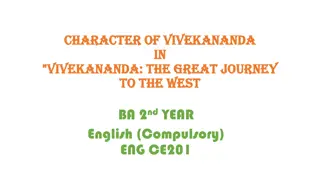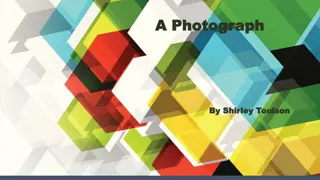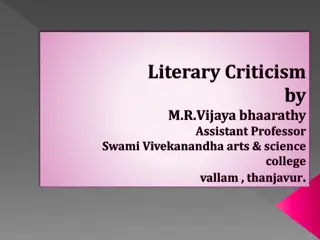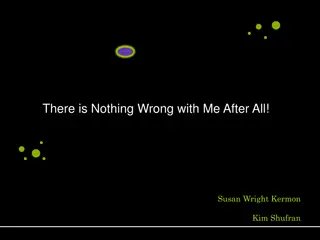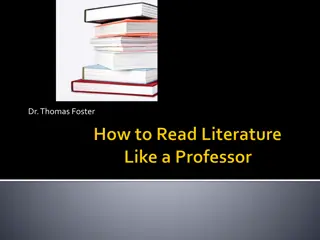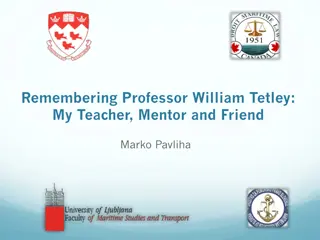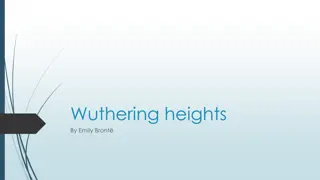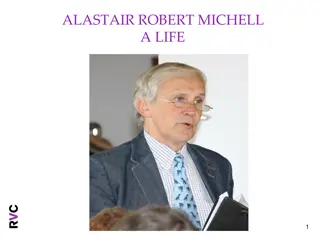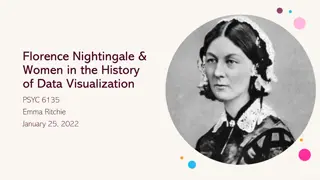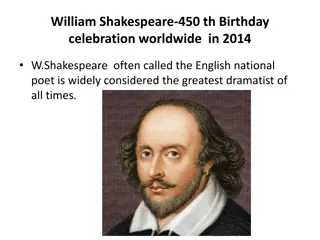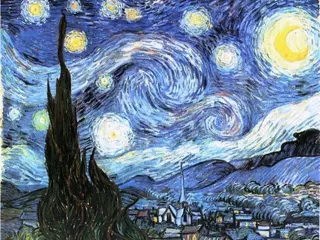The Literary Journey of Susan Thomas: A Tribute to Her Remarkable Contributions
Susan Thomas, a renowned writer born in British India, has left a lasting impact with her over 100 novels and 20 collections of short stories primarily written in Bengali. Her works reflect on social issues, highlighting the lives of subaltern groups such as tribals, dalits, women, and peasants. Through awards like the Sahitya Akademi Award and Jnanpith Award, she has been recognized for her significant contributions to literature and society, bringing attention to moral degradation and corruption in elite classes.
Download Presentation

Please find below an Image/Link to download the presentation.
The content on the website is provided AS IS for your information and personal use only. It may not be sold, licensed, or shared on other websites without obtaining consent from the author.If you encounter any issues during the download, it is possible that the publisher has removed the file from their server.
You are allowed to download the files provided on this website for personal or commercial use, subject to the condition that they are used lawfully. All files are the property of their respective owners.
The content on the website is provided AS IS for your information and personal use only. It may not be sold, licensed, or shared on other websites without obtaining consent from the author.
E N D
Presentation Transcript
Susan Thomas Department of English Mar Thoma College, Tiruvalla
Born in 1926 in Dhaka, British India to writer parents. Father: Manish Ghatak ( famous poet and novelist) Mother: Dharitri Devi (Writer and Social worker) Maternal Uncle: Sankha Chaudary (Noted Sculpter) Sachin Chaudary (Founder - Editor of the Economic and Political weekly of India) Paternal Uncle: Ritwik Ghatak (Noted Film maker) Schooling in Dhaka (after partition she moved to West Bengal)
BA (Hons) in English (Vishwabharathi University) MA (English) from Calcutta University 1964, joined Bijoygarh College as Lecturer also worked as a Journalist and Creative writer. 1947, married playwright Bijon Bhatacharya 1948, her son Nabarun Bhatacharya was born 1962, Divorced Bhatacharya and married writer Asit Gupta.
Over 100 novels and over 20 collections of short stories primarily written in Bengali. First novel titled 'Jhansir Rani' based on biography of Rani of Jhansi (1956) Hajar Churashir Maa (1974) Agnigarbha (1978) Aranyer Adhikar (1979) Stanadayini (1980) Chotti Munda Evam Tar Tir (1980)
Sungarsh (1968) Rudaali (1993) Hazaar Chaurasi Ki Maa (1998) Maati Maay (2006) Gangor (2010) Ullas (2012)
Sagaree, Mandira Sen Gupta Gayatri Chakravorty Spivak (Imaginary Maps, Old Woman, The Breast Stories) Ipsita Chanda Sumanta Banerjee Sunandini Banerjee Anjum Katyal
1979: Sahitya Akademi Award 1986: Padma Shri (For social work) 1996: Jnanpith Award 1997: Ramon Magsaysay Award 2006: Padma Vibhushan 2007: SAARC Literary Award 2009: Shortlisted for Man Booker International Prize. 2011: Banga Bibhushan (Highest Civilian Award from Govt. of West Bengal)
Brought the life of the subaltern to the attention of the main stream (the tribals, dalits, women and peasantry) Social and Historical Events in their temporal and spatial settings Moral degradation and corruption of the Elite and the upper classes Question of Human rights of the subaltern group.
I Phase (1956 to 1965) Publications of 19 titles including three novels Jhansir Rani (1956), Nati (1957) and Tales of Love and War based on the oral legends in Bhundelkhand Area. II Phase (1966 to 1975) 9 titles including Andharmanik (1967), Hajar Chaurasi ki Maa (1973) etc She wrote many short stories with rural and urban settings.
III Phase (1976 to 1985) She Gained prominence as a regional writer. A period of great transformation in Devi's life Takes up the cause of the tribal dispossessed groups. 27 famous titles in this period including Arnyer Adhikar and Agnigarbha. Environmental Concerns Experimented with language and style during this period. Gained national recognition as writer of margins IV Phase (1986 Onwards) Few significant titles Totally involved in Social Activism Fame in the international arena as a committed and original writer from the IIIrd world.
Problematization and displacement of the conventional connotations of 'nation' - by exposition of people who have been left out. Portrays tribal culture as an 'Advanced Cultural Heritage' and stress on tribals rights. Resurrects and record the tribal struggles and revolts - forgotten by the official history of the nation (Chotti Munda etc) The subalterns/tribals perspectives on main stream historical happenings and traditional heroes
Rewrites 'fictional' history (from below) Questions the 'invisibility' or 'silencing' of tribal narratives. Challenges the 'monolithic' understanding of past events. Deconstruct cultural history of the nation by rewriting dominant myths and replacing them with the local tribal myths (after Kurukshetra.
Speaks out for roughly 8% national population who have been Other-ed . Her writings bring out the dissent and protest of the oppressed and exploited communities. Exposes flaws in policy making of the state by highlighting economic marginalisation . Questions the hegemonic, rigid caste-stratified Indian social system (E.g. Five Women). Publishes the writings of tribals and non-tribal low- literacy groups and village women in the quarterly Bortika. Stories are Activist interventions against the modern bureaucratic nation-state.
I am not a Feminist Resists a homogenous category of Indian Woman Portrayal of woman is variegated (E.g. upper class Brahmanical widows to witches to slow-wits). Addresses the gap in Indian feminism (Dalit activism). Transgresses traditional female protagonists (E.g. Bayen) that ideologically presents woman as a carrier of nation s identity (E.g. Jashoda in Breast Giver/ Iconic Jashoda, Draupadi etc.) Deflates concepts of Ideal Woman/Mother.
Overturns the established notions of narration (activism is the defining principle of her aesthetics). Gaps and Ambivalences in her narratives reorient the responses of her readers. Reworks ancient tales, songs, history (esp. folklore), and uses them in her stories. Direct interventions in the narrative (through Questions) Use of idioms, repetitions, fairytales, Rhetoric Questions, Parallels Deconstructs Religion in Hegemony Body-language and Language of Resistance Unconventional Imagery and Symbols
Portrays how building of roads, railroads, dams, bridges invade tribal space. Development should not take place by defiling ecology. Exposes the Progressiveness of the Industrialists, builders, land-promoters (E.g. Pterodactyl). Aranya Samskritis (nature as gods) to extinction of land, rivers and seas. Role of Western Civilization in exploitation of nature. Maps the journey of tribals from their forest homes to agricultural fields to industrial belts (The Book of the Hunter). The forest is our mother She gives us everything, keeps us alive Doesn t that make her our mother? (Tejota)
In Jashoda Sindhu Giribala Ma from Dawn to Dusk Jamunabati s Mother
Mahasweta Devi wonderfully illustrated the might of the pen. A voice of compassion, equality and justice she leaves us deeply saddened. (Prime Minister, Narendra Modi tweeted) Died on 28th July, 2016, of multiple organ failure.
Susan Thomas Department of English Mar Thoma College Tiruvalla.
